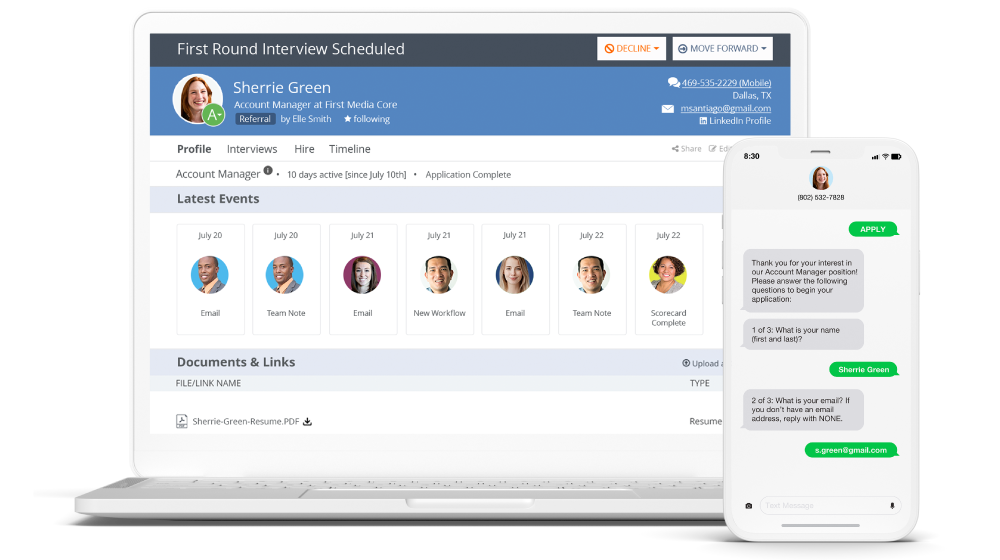This article about the impact of employee recognition was originally published in August 2014 and was updated in December 2023 with new information and sources.
In human resources, we’re always looking for ways to motivate our employees and help them do their best. We also want to build a solid company culture that attracts employees whose values align. And — perhaps most importantly today, with research showing more than half of workers worldwide want to quit their jobs — we want to keep giving them more reasons to stick around.
Did you know there’s a reliable employee engagement strategy that covers all of those bases? It’s called employee recognition. An effective employee recognition program can have a positive impact on your workforce that permeates the entire employee experience. 37% of employees say recognition is the top way their company can help them succeed.
Despite its impact on employee morale, nearly two-thirds of businesses say they have no budget allocated for recognition programs. 29% of employees say they’re never recognized at work, and it’s one of the top three reasons they cite for quitting. It’s clear there’s lots of room for improvement for most companies.
Keep reading to learn more about the many benefits of employee recognition plans.
🏆 Did you know that 37% of employees say recognition is the top way their company can help them succeed? Discover more about the powerful impact of employee recognition:Motivate and Engage Employees
We have an employee engagement problem, and it’s vital to take steps against it at your organization. U.S. employee engagement fell to 32% in 2022 after reaching 36% in January 2020, a record high since Gallup first reported the metric in 2000. This sparked trends like the Great Resignation, where record numbers of employee left their jobs, and quiet quitting, where those who stayed decided to do just the bare minimum.
Actively disengaged employees aren’t just contributing less at work — they’re doing damage to the business. Worldwide, these disengaged, unmotivated employees cost businesses nearly $9 trillion in lost productivity every year. They’re more likely to be looking for a new job and report higher levels of stress. Compared to quiet quitters, those who are actively disengaged are also more vocal about their unhappiness at work, which can have a negative effect on morale company-wide.
Luckily, employee recognition and engagement go hand in hand, so building or bolstering your recognition program is a reliable strategy for beating these concerning engagement trends. 53% of employees say they’d stay at their jobs longer if they felt more appreciated, and 37% say recognition is their top motivator to do good work. Recognition even makes employees 44% more likely to be thriving in their personal lives.
Another reason recognition is so effective is that is helps build connections between employees and their work, as well as employees and their colleagues. Your acknowledgment shows employees how their work makes achieving company goals possible, which is motivating and helps fuel a sense of purpose. Try peer-to-peer recognition for an even bigger impact: research shows it’s 36% more likely to have a positive impact than praise from a manager.

Drive Productivity
Get Specific for Great Recognition
“Don’t say ‘good job,’” Amy Freshman, senior director of global human resources for payroll giant ADP, told CNBC. “That doesn’t really do anything. Tell the person the specific things they did, how you experienced it, and the impact it had on team members and the organization. When someone knows the difference they made, that’s when they feel valued, and they’re more likely to want to stay.”
Did you know that 69% of employees say they’d work harder if they were recognized more often? If you regularly put your best effort into anything, and it goes unnoticed, you’ll probably be discouraged from doing that thing.
Think about it: imagine you’re an A student who studies hard to earn good grades. What if your teacher never takes notice of your hard work and doesn’t encourage you to keep it up? What if everyone gets the same grades, regardless of their level of effort? Without motivation, rewards, or even good grades to incentivize you, you’re probably going to stop working so hard in that class.
It’s not much different at work. When your employees are motivated, feel supported and encouraged, and their positive behaviors are rewarded, they’re going to be able to accomplish more. Consistent recognition also gives employees clarity around the ways their work furthers company goals, creating goal alignment that fosters purpose and productivity.
Positive reinforcement inspires your employees to repeat — and for the most motivated, even surpass — their previous accomplishments. The positive feedback loop creates a continuous cycle of productivity that you’ll see reflected in your business’s bottom line.
Retain More Employees
As we mentioned earlier, many employees are in danger of active disengagement or quiet quitting. So it’s no surprise that retention is a hot topic, with every organization looking for new ways to hold onto their people. 51% of companies are even ranking retention as their top business priority, beating out revenue growth, and 65% of HR teams say it’s more important than attracting top talent.
🏆 Did you know that 37% of employees say recognition is the top way their company can help them succeed? Discover more about the powerful impact of employee recognition:Luckily, recognizing employees is proven to reduce turnover at organizations of all types and sizes. Genuine, consistent recognition makes employees 56% less likely to be looking for a new job. It makes them feel good about the work they’re doing and 73% less likely to feel frequent burnout.
Recognized employees also often feel more invested in their professional growth within the company, which makes them more likely to stay. That’s a win-win scenario for you and your employees: they see a clear path for advancement, and your organization retains its top talent.
It’s no shock that feeling appreciated leads to team members that stick around longer and grow within your organization. But it might shock you to learn just how much employee recognition programs can pay off. Enterprise companies with 10,000 or more employees can expect to save more than $16 million in annual turnover costs alone when they start a recognition program. That’s without considering the savings from higher engagement and productivity.
Employee recognition is not only a morale booster but also a powerful tool in retaining employees. By fostering a culture of appreciation and celebrating achievements, you can create a work environment where employees choose to stay. Your business reaps the rewards of a tenured, knowledgeable workforce.
Build Company Culture
Company culture is formed day-to-day — it shapes, and is shaped by, how work gets done and how people communicate. It’s also shaped by what kinds of behavior are recognized and rewarded, as well as the methods for recognition and rewards your company uses. So, if you want to create a workplace where efficiency and collaboration abound, you need to appreciate and encourage behavior that contributes to that environment.
85% of HR leaders say recognition programs have a positive impact on organizational culture. Recognition also has a powerful effect on how your employees feel about their workplace, which shapes culture. When they’re recognized, employees are:
- 2.6x more likely to say they think promotions are fair
- 2.2x more likely to say innovative thinking is embraced
- 2x more likely to say their colleagues are willing to go above and beyond
Even though saying thank you may seem obvious, the reality is that you need a fully developed employee recognition plan to create a culture of recognition. An easy-to-follow process and designated channels for proper recognition establish the importance of expressing appreciation and help build a sense of camaraderie among your workforce.
Did You Know? When recognition is part of company culture, seven in ten employees agree they feel strongly connected to the culture.
Employee Recognition Ideas to Try
While the best way to recognize your people is in the way they prefer, there are some types of recognition that can work for lots of companies. Here are a few ideas for how you can recognize and reward employees:
- Public Recognition: In many roles, publicly recognizing an employee’s excellent work can be highly motivating for the entire team. You might give shout-outs during meetings or in team Slack channels or post their picture on the employee of the month board.
- Personal Recognition: Some of your employees may prefer more personal, heartfelt recognition. In this age of digital communication, a handwritten note or personal phone call, especially from leadership, can be highly rewarding.
- Financial Rewards and Incentives: When you want to incentivize great work and take employee recognition up a notch, financial rewards are key. Your options range from raises and stock options to gift cards and bonuses.
- PTO: Extra time off is an excellent way to reward good work for PTO-eligible employees. You can use it as a reward to incentivize performance or give it out unexpectedly, even just by sending your team home early.
Recognition programs don’t have to be complicated — they should work for your business and benefit your people. It’s easy to integrate recognition into everyday processes with the help of employee engagement software.
With ClearCompany Employee Engagement, you can leverage many powerful recognition tools:
- Any employee can show appreciation for their colleagues with Shout Outs, public notes of thanks that are published in the company news feed and in a Slack channel (if you’d like). Shout Outs are accessible in the employee’s profile at any time and are visible to managers conducting their performance reviews.
- Similarly, the Celebrations feature can automatically post employee milestones, like birthdays and work anniversaries, to the news feed or Slack. Celebrations make it easy for employees to send well wishes to their colleagues on these important days and help foster engagement-boosting work relationships.
- Goal Planning tools enable managers to post public feedback to the company news feed whenever their employees post updates. They also help managers determine when employees are crushing their goals or falling behind so they can adjust goals accordingly.
See these employee recognition tools, plus even more engagement features, including employee surveys, in action. Sign up for your custom demo of ClearCompany Employee Engagement today.


